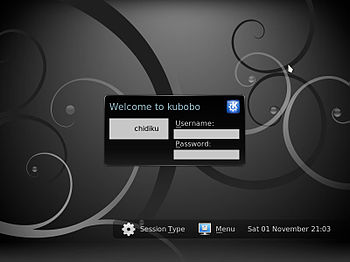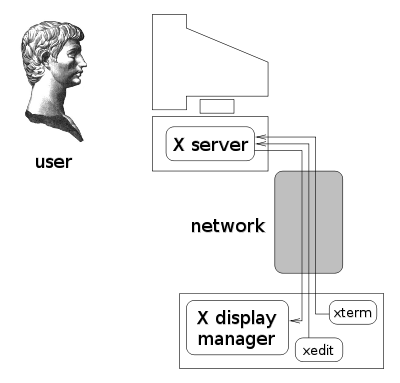- X display manager (program type)
-
For the program called "X Display Manager", see XDM (display manager).
In the X Window System, an X display manager runs as a program that allows the starting of a session on an X server from the same or another computer.
 A login screen shown by the KDM display manager.
A login screen shown by the KDM display manager.
A display manager presents the user with a login screen which prompts for a username and password. A session starts when the user successfully enters a valid combination of username and password.
When the display manager runs on the user's computer, it starts the X server before presenting the user the login screen, optionally repeating when the user logs out. In this condition, the display manager realizes in the X Window System the functionality of init, getty and login on character-mode terminals. When the display manager runs on a remote computer, it acts like a telnet server, requesting username and password and starting a remote session.
X11 Release 3 introduced display managers in October 1988 with the aim of supporting the standalone X terminals then just coming onto the market. Various display managers continue in routine use to provide a graphical login prompt on standalone computer workstations running X. X11R4 introduced the X Display Manager Control Protocol (XDMCP) in December 1989 to fix problems in the X11R3 implementation.
Contents
Local and remote display management
A display manager can run on the same computer where the user sits or on a remote one. In the first case, the display manager starts one or more X servers, displaying the login screen at the beginning and (optionally) every time the user logs out. In the second case, the display manager works according to the XDMCP protocol.
The XDMCP protocol mandates that the X server starts autonomously and connects to the display manager. In the X Window System paradigm, the server runs on the computer providing the display and input devices. A server can connect, using the XDMCP protocol, to a display manager running on another computer, requesting it to start the session. In this case, the X server acts as a graphical telnet client while the display manager acts like a telnet server: users start programs from the computer running the display manager, while their input and output take place on the computer where the server (and the user) sits.
An administrator can configure an X server running on the computer or terminal of the user either to connect to a specific display manager, or to display a list of suitable hosts running potential X display managers. An XDMCP Chooser program allows the user to select a host from among those the terminal can connect to:
- a predefined list of hosts and their respective network addresses;
- a list of hosts (on the local TCP/IP subnet) that the XDMCP server (part of the X server?) in turn obtains by a network broadcast
The XDMCP server will often present itself in this list. When the user selects a host from the list, the X server running on the local machine will connect to the selected remote computer's X display manager.
X Display Manager Control Protocol
The X Display Manager Control Protocol uses UDP port 177. An X server requests that a display manager start a session by sending a
Querypacket. If the display manager allows access for that X server, it responds by sending aWillingpacket back to the X server. (The X server can also sendBroadcastQueryorIndirectQuerypackets to start a session - this mechanism for requesting a session resembles using DHCP to request an IP address.)The display manager must authenticate itself to the server. To do this the X server sends a
Requestpacket to the display manager, which returns anAcceptpacket. If theAcceptpacket contains the response the X server expects, the display manager is authenticated. Producing the correct response might require the display manager to have access to a secret key, for example. If authentication succeeds, the X server sends aManagepacket to inform the display manager. Then the display manager displays its login screen by connecting to the X server as a regular X client.During the session, the server can send
KeepAlivepackets to the display manager at intervals. If the display manager fails to respond with anAlivepacket within a certain time, the X server presumes that the display manager has ceased running, and can terminate the connection.One problem with XDMCP is that, similarly to telnet, the authentication takes place unencrypted. If snooping is possible, this leaves the system vulnerable to attack. It is more secure to use an ssh tunnel for X traffic.[1]
History
XDM (the X Window Display Manager) originated in X11R3. This version suffered from several problems, most notably when users switched X terminals off and on. In X11R3, XDM only knew about an X terminal from its entry in the Xservers file, but XDM only consulted this file when it started. Thus every time a user switched a terminal off and on, the system administrator had to send a SIGHUP signal to XDM to instruct it to rescan Xservers.
XDMCP arrived with the introduction of X11R4 (December 1989). With XDMCP, the X server must actively request a display manager connection from the host. An X server using XDMCP therefore no longer requires an entry in Xservers.
Some implementations
The X Window System supplies XDM as its standard display manager.
Programmers have developed other X display managers, both commercial and free, offering additional functionality over the basic display management:
- GDM (GNOME)
- KDM (provided by KDE) allows the user to graphically select a window manager or desktop environment in the login screen
- XDM, the default X Window System Display Manager
- XDM-OPTIONS for xdm. Easy full install, Xhost Phonebook, X Login, X Desktop Chooser, menu-reconfig, repair utils.
- LDM, the (remote) Display Manager of the Linux Terminal Server Project
- dtlogin (shipped with CDE)
- scologin (provided by SCO Open Desktop) also checks for expired passwords and performs some administrative tasks
- WINGs Display Manager (using the WINGs widget-set used in Window Maker)
- entranced/entrance (employs the architecture used in Enlightenment v.17, on hiatus since 2005)
- LXDM, a lightweight display manager, part of LXDE, cross-desktop, fully themeable
- SLiM, an independent login manager.
- CDM, an ultralight Console Display Manager for Linux
- xlogin, X Window login with separate XDMCP server
- Enter Lightweight graphical login manager
- Orthos, another lightweight solution with very configurable animated themes that use OpenGL only
- nodm, auto-login display manager for systems like kiosks, appliances and mobile phones
- LightDM, a lightweight, modular, cross-desktop, fully themeable desktop display manager
On most Linux distributions, the default display manager is selected in file /etc/X11/default-display-manager
See also
References
- XDMCP specification, from the X.Org release documentation
- XDM manual page (XFree86.org)
- Linda Mui and Eric Pearce, X Window System Volume 8: X Window System Administrator's Guide for X11 Release 4 and Release 5, 3rd edition (O'Reilly and Associates, July 1993; softcover ISBN 0-937175-83-8)
External links
- Linux XDMCP HOWTO
- Taming The X Display Manager
- The X Display Manager, from the *FreeBSD Handbook
- Linux login with a Windows box and XDMCP A guide to login to linux using windows.
Footnotes
X Window System Architecture Core protocol · Xlib · X Window selection · X window manager · X session manager · X display manager · X Toolkit Intrinsics · X Window authorization · X11 color namesWindow managers Extensions X Image Extension · X keyboard extension · RandR · X Rendering Extension · Shape extension · Shared memory extension · X video extension · AIGLX · GLX · Multi-Pointer X · Display PostScriptNotable implementations Standards Applications Categories:- X Window System
- X display managers
Wikimedia Foundation. 2010.

